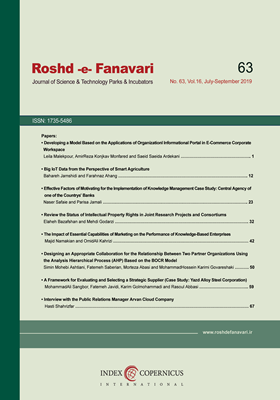طراحی مدل الگوی مناسب همکاری جهت رابطه میان دو سازمان همکار با استفاده از فرایند تحلیل سلسله مراتبی (AHP) و بر مبنای مدل BOCR
الموضوعات : Innovation and Inventionمرتضی عباسی 1 , سیمین محبی آشتیانی 2 , محمدحسین کریمی گوارشکی 3 , فاطمه صابریان 4
1 - مالک اشتر
2 - مالک اشتر
3 - مالک اشتر
4 - الزهرا
الکلمات المفتاحية: الگوهای همکاری اتحاد راهبردی سرمایهگذاری مشترک تملک برونسپاری فرایند تحلیل سلسله مراتبی (AHP),
ملخص المقالة :
امروزه با افزایش رقابت جهانی در فضای کسب و کار، شرکتها برای بقا و دستیابی به سود معقول نیاز به یک رابطه تنگاتنگ با تأمینکننده خود دارند. اخیراً محققان، مدلهایی را برای انتخاب تأمینکننده بررسی کردهاند، که به موضوع تعیین الگوی همکاری با همکاران منتخب توجه کمتری شده است. با وجود تحقیقات زیادی که درخصوص انواع مدلهای همکاری، ویژگیها، الزامات و دستاوردهای آنها صورت گرفته، ولی ارائه یک الگو مناسب و جامع برای انتخاب مناسبترین نوع رابطه میان دو سازمان همکار مورد توجه کافی قرار نگرفته است. بهطور کلی الگوهای همکاری بین تأمینکننده- خریدار شامل برونسپاری، اتحاد راهبردی، سرمایهگذاری مشترک و تملک میباشد. هدف از این تحقیق طراحی مدلی است که با توجه به ویژگیهای محصول، شرایط کسب و کار و اهداف سازمان الگوی همکاری مناسب تعیین میشود. در این مدل از ساختار سود، فرصت، هزینه و ریسک که یک الگو جامع و پرکاربرد برای در تصمیمات راهبردی میباشد، استفاده شده است. در این تحقیق، انتخاب الگوی همکاری میان دو سازمان همکار، در جهت طراحی اجزا رادار بررسی شده است. با مطالعه کتابخانهای و مصاحبه با خبرگان سازمان صنعت دفاعی ایران، عوامل مؤثر بر انتخاب الگوی همکاری مناسب برای رابطه میان دو سازمان همکار، شناسایی و اولویتبندی گردید. یک مدل فرایند تحلیل سلسله مراتبی (AHP) جهت اولویتبندی معیارها و زیرمعیارهای مربوطه طراحی شده است. مقایسات زوجی براساس نظر خبرگان صورت پذیرفته و نتایج به کمک نرمافزار سوپر دسیژن تحلیل شده است.
1- الفت، لعيا.؛ براتي، مسعود.؛ ولدی، محمدرضا،" چارچوبي برای تصميم برونسپاری راهبردی، مطالعه موردی: تعيين راهبردهای تأمين مجموعههای توليدی بدنه خودرو سمند"، فصلنامه علمي پژوهشي مطالعات مدیریت صنعتي، سال نهم، شماره 25، تابستان 91، صص 27-50، 1391.
2- ابراهیمی، مهدی؛ رحمان سرشت، حسین، شراکت راهبردی، تهران، انتشارات علامه طباطبایی، 1393.
3- Amy H. I. Lee, A fuzzy AHP evaluation model for buyer–supplier relationships with the consideration of benefits, opportunities, costs and risks, International Journal of Production Research, 47:15, 4255-4280, 2007.
4- Cheisa, v "R&D Strategy and Organizaton. managing technical change in dynamic context", Imperial College press, 2001.
5- Hoffmann, W.H. and Schlosser, R., Success factors in strategic alliances in small and mediumsized enterprises – an empirical survey. Long Range Planning, 34, 357–381, 2001.
6- Dacin, M.T. and Hitt, M.A., Selecting partners for successful international alliances: examination of U. S. and Korean firms. Journal of World Business, 32 (1), 3–16, 1997.
7- Chen, C. J., The effects of environment and partner characteristics on the choice of alliance forms. International Journal of Project Management, 21, 115–124, 2003.
8- Townsend, J. D., Understanding alliances: a review of international aspects in strategic marketing. Marketing Intelligence & Planning, 21 (3), 143–156, 2003.
9- Yasuda, H. and Iijima, J., Linkage between strategic alliances and firm’s business strategy: the case of semiconductor industry. Technovation, 25, 513–521, 2005.
10- Das, T. K. and Teng, B.- S., Partner analysis and alliance performane. Scandinavian Journal of Management, 19, 279–308. 2003.
11- Murray, J.Y., Kotabe, M., and Zhou, J.N., Strategic alliance-based sourcing and market performance: evidence from foreign firms operating in China. Journal of International Business Studies, 36, 187–209, 2005.
12- Gill, C. Liestmann V. and Bleck, S. Strategisches Management von Unternehmenskooperationen (Strategic management of corporate cooperations) In: Luczak, H.; Schenk, M.: (Cooperation in theory and practice. Human, organizational and legal aspects of cooperation in industrial services of ..., Dusseldorf: VDI Publishing House, pp. 257-270, 1999.
13- Whipple, J. M. and Frankel, R., Strategic alliance success factors. Journal of Supply Chain Management, 36 (3), 21–28, 2000.
14- Todeva, E. and Knoke, D., Strategic alliances and models of collaboration. Management Decision, 43 (1), 123–148, 2005.
15- Wheelen, T. L. and Hungar, D.J., Strategic Management and Business Policy. New York: Addison- Wesley, 2000.
16- Zineldin, M. and Bredenlow, T., Strategic alliance: synergies and challenges: a case of strategic outsourcing relationship ‘SOUR’. International Journal of Physical Distribution & Logistics Management, 33 (5), 449–464, 2003.
17- Zineldin, M. and Jonsson, P., An examination of the main factors affecting trust/commitment in supplier– dealer relationships: an empirical study of Swedish wood industry. The TQM Magazine, 12 (4), 245–65, 2000.
18- Malott, R. H., Managing the global enterprise. Executive Speeches, 7 (4), 6–10, 1992.
19- Michelet, R. and Remacle, R., Forming successful strategic marketing alliance in Europe. Journal of European Business, 4 (1), 11–15, 1992.
20- Soursac, T, When the hub spoke. The Alliance Analyst, 1–4 , 1996. [online]. Available from: http://www.allianceanalyst.com [Accessed 30 January 2007],
21- Elmuti, D. and Kathawala, Y., An overview of strategic alliances. Management Decision, 39 (3), 2005–2017. 2001.
22- Kalmbach Jr, C. and Roussel, C., Dispelling the myths of alliances. Outlook, October, 5–32. 1999.
23- Amy H.I. Lee, Hsing-Jen Chang, Chun-Yu Lin, An evaluation model of buyer–supplier relationships in high-tech industry. Computers & Industrial Engineering ,57, 1417–1430, 2009.
24- Saaty, R.W., 2003. Decision making in complex environment: the analytic hierarchy process (AHP) for decision making and the analytic network process (ANP) for decision making with dependence and feedback. Pittsburgh, PA: Super Decisions.
25- Saaty, T.L., Theory and applications of the analytic network process: Decision making with benefits, opportunities, costs, and risks. Pittsburgh, PA: RWS Publications, 2005.
26- Saaty, T.L. and Ozdemir, M., Negative priorities in the analytic hierarchy process. Mathematical and Computer Modelling, 37, 1063–1075, 2003.
27- Erdogmus, S., Kapanoglu, M., and Koc, E., Evaluating high-tech alternatives by using analytic network process with BOCR and multiactors. Evaluation and Program Planning, 28, 391–399. 2005.


